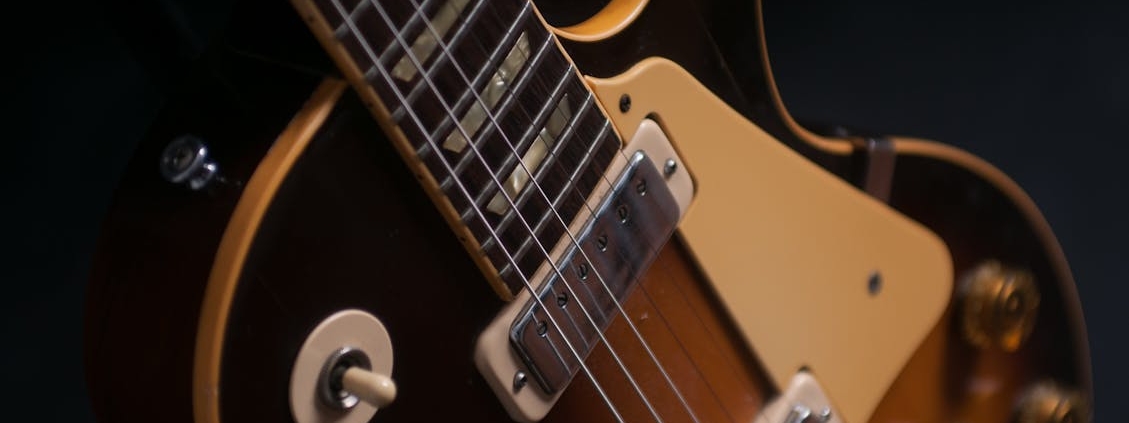Unleashing the Tonal Power of the Gibson Les Paul and Similar Guitars
The Gibson Les Paul, a legend in its own right, carries a distinctive tonal character that has shaped the sound of rock ‘n’ roll. Its iconic status is not only due to its aesthetic appeal but also its versatile sound, which can be tailored to a wide range of musical styles. In this guide, we’ll embark on a journey to understand and harness the diverse tonal settings of your Les Paul (or any guitar with a similar construction). Get ready to dive into the depths of your instrument’s sonic possibilities.
Mastering the Toggle Switch
The toggle switch on your Les Paul is your gateway to tonal exploration. It offers three positions, each unlocking a different sonic character:
Position 1: Rhythm Pickup (Neck Pickup)
- Tonal Characteristics: Engages the neck pickup for warm, round tones with rich low frequencies. This setting is perfect for smooth jazz chords, bluesy riffs, and soulful leads.
- Usage Tips: Ideal for genres that require a full, mellow sound. Experiment with this setting when playing ballads or soft rock.
Position 2: Both Pickups
- Tonal Characteristics: Combines both the neck and bridge pickups, delivering a balanced tonal spectrum. This position offers a mix of the warmth of the neck pickup and the brightness of the bridge pickup.
- Usage Tips: Great for versatile rhythm playing. Use this setting for a balanced tone that suits a wide range of styles, from rock to pop.
Position 3: Treble Pickup (Bridge Pickup)
- Tonal Characteristics: Activates the bridge pickup, producing bright, cutting tones with enhanced treble frequencies. This setting excels in delivering sharp, defined sounds.
- Usage Tips: Perfect for searing lead lines, crunchy rhythms, and genres like hard rock and metal where a bright, punchy tone is desired.
Tapping into the Volume and Tone Knobs
Your Les Paul comes equipped with separate volume and tone knobs for each pickup. These controls allow you to fine-tune the tonal characteristics of your guitar:
Volume Knobs
- Function: Adjusting the volume knobs affects the output level of each pickup. By experimenting with different combinations, you can find the perfect balance for your playing style.
- Usage Tips: Lower the volume for a cleaner sound or crank it up for more drive and intensity. Mixing the volume levels of both pickups can create unique tonal blends.
Tone Knobs
- Function: These knobs allow you to adjust the high frequencies of each pickup. Turning them clockwise reduces the highs, resulting in a warmer, smoother tone, while counterclockwise brightens the sound.
- Usage Tips: Roll off the tone for a jazzier, darker sound or brighten it up for more clarity and presence. This is especially useful for adapting your tone to different genres and playing contexts.
Amplifier Settings: Your Tonality Ally
Just like with any guitar, your amplifier plays a crucial role in shaping your tone. Experiment with settings like gain, EQ, and reverb to complement your Les Paul’s tonal variations. Here are some tips:
- Gain: Adjust the gain to control the level of distortion. Lower gain settings are great for clean or slightly overdriven sounds, while higher gain settings can push your tone into heavier distortion.
- EQ: Use the EQ controls to shape the bass, midrange, and treble frequencies. Tailoring these settings can help you achieve a more balanced or a more pronounced tone, depending on your needs.
- Reverb: Adding reverb can enhance the spaciousness of your sound, giving it more depth and atmosphere.
Effect Pedals and Your Les Paul
Effect pedals are your ticket to expanding your sonic horizons. Experiment with pedals like overdrive, distortion, delay, and modulation to add depth and color to your sound. Consider how these effects interact with your chosen pickup configuration:
- Overdrive/Distortion: These pedals can add grit and sustain to your tone. Use them to enhance your lead lines or add crunch to your rhythms.
- Delay: Delay pedals can create echoes and repeats, adding texture to your playing. They are great for creating ambient sounds and layering.
- Modulation: Effects like chorus, flanger, and phaser can add movement and complexity to your tone. Experiment with these to find unique sounds that complement your style.
Trust Your Ears and Fine-Tune
Ultimately, your ears are the best judges of your tonal preferences. Spend quality time exploring different configurations and pay attention to how each setting impacts the sound. Make adjustments based on what resonates with your musical sensibilities. Here are some tips:
- Record and Review: Record your playing with different settings and listen back to see which tones you prefer.
- Live Testing: Test your settings in a live setting if possible, as this can reveal how your tone interacts with other instruments and the room acoustics.
- Continuous Experimentation: Don’t be afraid to continually tweak and experiment. Your preferences might evolve over time, and new gear or techniques might inspire different tonal settings.
Conclusion
Your Gibson Les Paul is a tonal powerhouse, ready to unleash a world of sonic creativity. By understanding and manipulating the various tone settings, you’ll unlock new dimensions in your playing. Embrace experimentation, trust your instincts, and let your unique voice shine through your instrument. Happy playing!
—
If you want to set up a free trial lesson either in person or online, simply fill out this form and we’ll get back to you within 24 hours. You’ve got nothing to lose and an amazing musical world to gain. 🙂



